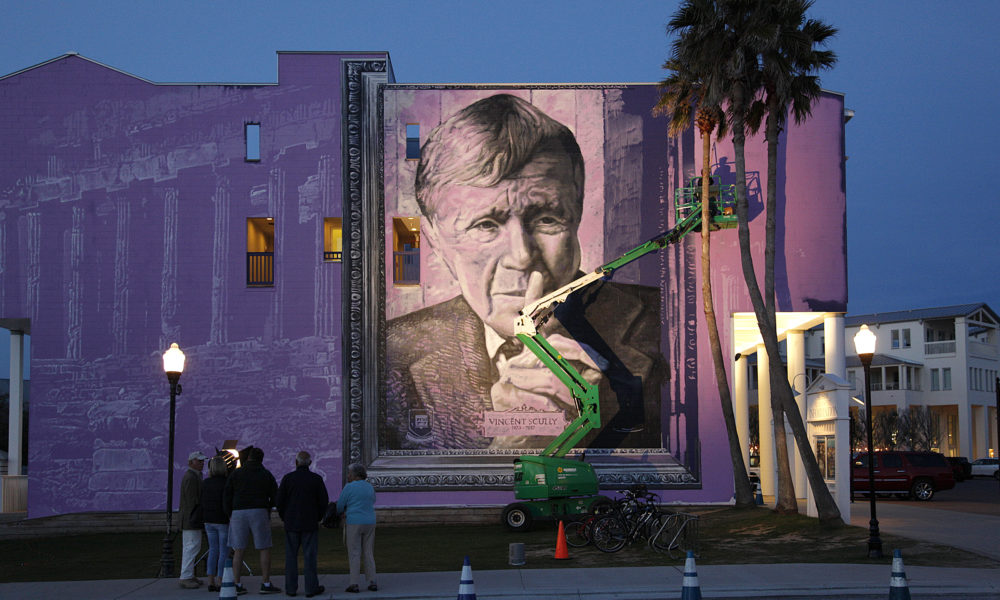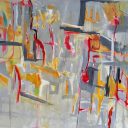“I just felt that something more universal might be appropriate,” a local tourism official says when I asked him what he thought of the four-story mural of Vincent Scully, painted on the purple wall of the famous Machedo & Silvetti building in Seaside. He continues, “A better message could be sent into the world about our area, something simple, like wings, that visitors to South Walton could connect to and repost on their social media pages.”
I wondered if he had a point.
Rodolfo Machedo and Jorge Silvetti are both currently among the most illustrious professors at the Harvard Graduate School of Design. Their architectural achievements are many, beginning with their building in Seaside Town Square, on Scenic Highway 30A.
Of course, their fame and talent served Seaside well in projecting America’s first new urbanist town to the top rank of architectural places to visit. But it was the vision of Robert and Daryl Davis, who had the eye, and above all the audacity, to take a very big chance with these then-young architects— a chance that they would take on young talent, time and again, throughout the thirty-five-year history of Seaside; right down to today, with the vast mural of Vincent Scully.
The Scully portrait on the purple sidewall was painted by Andrew Pisacane, the Street Artist known as Gaia. Commissioned by Dhiru Thadani and Robert Davis, the mural honors the art and architecture historian that inspired two of his most celebrated students: Andres Duany and Lizz Plater-Zyberk, who designed the town plan of Seaside, which became the model of the movement that came to be called the New Urbanism. It was first implemented at Seaside, before the movement continued to the equally important communities of Rosemary Beach, WaterColor, and Alys Beach. To date, their firm, DPZ, has designed more than 300 such communities around the world.
As one of Seaside’s early supporters, Scully’s influence would be felt by many who contributed their design, planning, and architecture talents to the young town. His death last November at age 97 was mourned by lovers of architecture and urbanism throughout the world. Scully taught architectural history at Yale for more than 50 years and then for almost 20 more at University of Miami. He authored more than 20 books. His undergraduate lectures at Yale were standing-room-only. He was known as the most dramatic, impassioned, and erudite teacher at the university. Scully was revered for being able to explain the innate relationship between architectural style, urbanism and the environment to the mainstream.
Scully inspired future architects with the idea of reconnecting contemporary architecture with its past, thereby planting seeds that grew into the New Urbanism movement. He also inspired a Street Artist named Andrew Pisacane, who applied Scully’s teaching to the importance of street art in architecture.
I read an interview linked on his 80,000-follower InstaGram page by Shelly Clay-Robinson. In it, Gaia explains his Street Art tactics:
“While ‘parachuting-in’ accurately denotes military engagement, it is ultimately a perfect metaphor for most contemporary Street Art operations. Ideally, an artist who works within the fabric of the public sphere functions as a tool for community—a set of skills to be employed to help promote a message that challenges the status quo and advocates for systemic change. Furthermore, this promotion of alternative narratives is enacted in such a fashion as to challenge the primacy of private property rights upon which liberal, representative democracy is founded.”
Gaia’s remark is why the tourism official had a point; not because parachutes could be synonymous with wings, but because the mural on the purple wall was making a statement; not only in our community, but also in the world. What was the point of painting the face of a man that few passersby knew, outside of the circle that was influenced by him—and on the most prominent wall on 30-A? The point might be the conversation around it. Which, in this case, leads to the historical underpinnings of our area’s unique history.
Within thirty-minutes of arriving in Seaside, Pisacane had transformed into Gaia. Donning his superhero paint clothes, he would spend 8 to 14 hours of the next five days, suspended in the air by an articulating boom lift, while facing concrete with his weapon of choice – paint. The artist would always, patiently and politely, look down to speak to anyone who engaged him and soon became beloved by all.
The final morning unveils Gaia’s towering masterpiece: it is Scully on our own Acropolis. Unleashed now, the beloved professor breaks into the silence of his Seaside. It is the sound of the great preceptor, with pursed lips and finger transcending above us all with wings, as if to say, “Listen, now…can you hear? I am no longer silent.”
Before Gaia left town he said, “This is a strange thing for me. My job is to drop in and shake things up, but I don’t want to “scorch-the-earth” here, I kind of like it.”
Featured in the March/April 2018 Issue of Thirty-A Review





